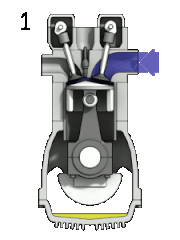Petrol engine

A petrol engine (gasoline engine in American and Canadian English) is an internal combustion engine designed to run on petrol (gasoline). Petrol engines can often be adapted to also run on fuels such as liquefied petroleum gas and ethanol blends (such as E10 and E85).
Most petrol engines use spark ignition, unlike diesel engines which typically use compression ignition. Another key difference to diesel engines is that petrol engines typically have a lower compression ratio.[1][2][3]
History
[edit]The first practical petrol engine was built in 1876 in Germany by Nicolaus August Otto and Eugen Langen, although there had been earlier attempts by Étienne Lenoir in 1860, Siegfried Marcus in 1864 and George Brayton in 1873.[4]
Design
[edit]Thermodynamic cycle
[edit]
Most petrol engines use either the four-stroke Otto cycle or the two-stroke cycle.[5][6][7] Petrol engines have also been produced using the Miller cycle and Atkinson cycle.[8][9][10][11]
Layout
[edit]Most petrol-powered piston engines are straight engines or V engines. However, flat engines, W engines and other layouts are sometimes used.
Wankel engines are classified by the number of rotors used.
Compression ratio
[edit]Cooling
[edit]Petrol engines are either air-cooled or water-cooled.
Ignition
[edit]Petrol engines use spark ignition. High voltage for the spark this may be provided by a magneto or an ignition coil. In modern car engines, the ignition timing is managed by an electronic Engine Control Unit. Ignition modules can also function as a rev limiter in some cases to prevent overrevving and the consequences of it, such as valve float and connecting rod failure.
Primer
[edit]Primers may be used to help start the engine. They can draw fuel from fuel tanks and vaporize fuel directly into piston cylinders. Engines are difficult to start during cold weather, and the fuel primer helps because otherwise there will not be enough heat available to vaporize the fuel in the carburetor.[12]
Power output and efficiency
[edit]The power output of small- and medium-sized petrol engines (along with equivalent engines using other fuels) is usually measured in kilowatts or horsepower.
Typically, petrol engines have a thermodynamic efficiency of about 20-30% (approximately half that of some diesel engines).[13]
Applications
[edit]Applications of petrol engines include automobiles, motorcycles, aircraft, motorboats and small engines (such as lawn mowers, chainsaws and portable generators). Petrol engines have also been used as "pony engines", a type of engine used to start a larger, stationary diesel engine.
See also
[edit]References
[edit]- ^ "How do car engines work?". Kia British Dominica. Retrieved 2024-11-11.
- ^ "Alternative Fuels Data Center: How Do Diesel Vehicles Work?". Retrieved 2024-11-11.
- ^ "Unterschied zwischen Diesel- und Benzinmotoren" [The difference between diesel and gasoline engines]. Retrieved 2024-11-11.
- ^ Clerk, Dugald (1911). . In Chisholm, Hugh (ed.). Encyclopædia Britannica. Vol. 20 (11th ed.). Cambridge University Press. p. 36.
- ^ "What is Otto Cycle - Complete Explaintion on P-v & T-s Diagram". The Engineers Post. 10 September 2019. Retrieved 14 August 2022.
- ^ "What is Two Stroke Engine?- Types, And Working". Engineering Choice. 12 November 2020. Retrieved 14 August 2022.
- ^ "Two Stroke Engine - Internal Combustion Engines (IC) - Automobile Magazine". MotorTrend. 16 December 2009. Retrieved 14 August 2022.
- ^ "How does a Miller-cycle engine work?". HowStuffWorks. 1 April 2000. Retrieved 14 August 2022.
- ^ "Mazda 2.3L Miller-cycle DOHC V-6". WardsAuto. 1 January 1998. Retrieved 14 August 2022.
- ^ "Why does Toyota use Atkinson cycle engines?". Toyota UK Magazine. 14 January 2015. Retrieved 14 August 2022.
- ^ "Engine Types: Atkinson Cycle vs Otto vs Miller". EngineHoist. 4 April 2016. Retrieved 9 June 2023.
- ^ "Chapter 7: Aircraft Systems". Pilot's Handbook of Aeronautical Knowledge (FAA-H-8083-25C ed.). Federal Aviation Administration. 2023-07-17. p. 25.
- ^ "Toyota Gasoline Engine Achieves Thermal Efficiency Of 38 Percent". Green Car Reports. Retrieved 2017-10-07.
